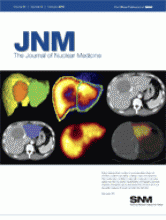REPLY: Dr. Heston emphasizes an important point with which we agree. As stated in our conclusions (1), any generalized statements regarding the use of 123I-metaiodobenzylguanidine (MIBG) and 18F-FDG in neuroblastoma will have clinically significant exceptions. It was not our intention to imply that either scan can be safely eliminated from the imaging evaluation of neuroblastoma. However, as most neuroblastoma patients are primarily diagnosed and followed with 123I-MIBG, the question is not whether scans can be safely eliminated; rather, the question is when addition or substitution of an 18F-FDG scan can give important information. 18F-FDG may be the preferred agent for most follow-up scans in patients with stage 1 or 2 disease when the tumor is better demonstrated with 18F-FDG at diagnosis and bone marrow involvement is highly unlikely. 123I-MIBG is likely to be the preferred agent for most follow-up scans in stage 4 patients with 123I-MIBG–avid disease. It is probably unnecessary for all neuroblastoma patients to undergo both functional imaging studies at all time points during their disease course, as long as it is recognized that addition or substitution of the second study will be beneficial in some clinical situations, in particular when there are discrepancies between anatomic evaluations and the functional imaging study, and at important decision points when completeness of the imaging evaluation may be particularly important.
Regarding the confidence intervals given by Dr. Heston, the 95% confidence interval for a proportion uses the estimated proportion from the study sample and allows for sampling error. If a study is conducted and an event occurs 0 times in n subjects, we need to examine the “upper limit” of the 95% confidence interval. In our study, the 95% “upper limit” for observing zero events would be 30.85%, which means that it is statistically possible that 123I-MIBG was superior to 18F-FDG in up to 3 of 10 patients.
Regarding the statistical questions raised by Drs. Nguyen and Osman, the methods of statistical analysis were not described in the article because no formal statistical testing was done. The estimated proportions presented in the paper were based on the total number of scans that were examined at each disease stage rather than in individual subjects. The proportions were meant to be descriptive in nature, and the confidence intervals were included to allow for sampling error. For calculation of confidence intervals, the simplest method is to approximate the binomial distribution with a normal distribution. This approximation applies well even when the sample size is less than 30, as long as the proportion is not too close to 0 or 1. Results presented were based on the normal approximation. When the confidence intervals are estimated using the Exact and the Wilson score interval, the results are nearly the same.
Our study included 13 scans of 10 patients with stage 1 or 2 disease. We agree with Drs. Nguyen and Osman that larger, multiinstitutional prospective trials may provide further information, as stated in our conclusions.
Drs. Nguyen and Osman also ask whether the better performance of either modality resulted in a change in clinical stage or clinical management. We did not specifically look at this question, but we do know of patients in whom management was altered on the basis of positive findings seen on only one of the studies. A stage 2 patient imaged after tumor resection had a normal 123I-MIBG scan, but was found to have a large amount of 18F-FDG–avid retroperitoneal disease (also seen on CT); the patient had repeat surgery with resection of residual retroperitoneal neuroblastoma. Follow-up imaging of a stage 4 patient showed 123I-MIBG–avid skull lesions not identified on 18F-FDG; the patient received local radiation therapy. Nine 18F-FDG scans showed uptake in neuroblastoma when the corresponding 123I-MIBG scans were negative. Eleven 123I-MIBG scans showed uptake in neuroblastoma when the corresponding 18F-FDG scans were negative. Clinical management could have been impacted in each of these cases.
In contrast to Kushner et al. (2), we found that 123I-MIBG was more reliable than 18F-FDG in the detection and follow-up of bone and marrow disease. Possible reasons for the differing results are consistent use of 123I-MIBG in our study, use of cell-stimulating factors in some patients in our study (resulting in intense marrow uptake of 18F-FDG), and inclusion of cranial findings in our study.
Footnotes
-
COPYRIGHT © 2010 by the Society of Nuclear Medicine, Inc.







